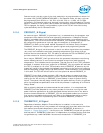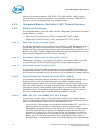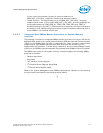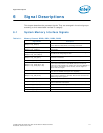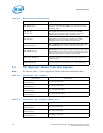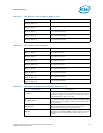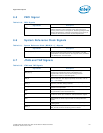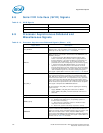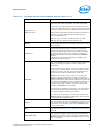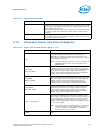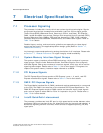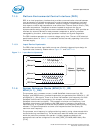
Intel® Xeon® Processor E5-1600 v2/E5-2600 v2 Product Families 121
Datasheet Volume One of Two
Signal Descriptions
6.5 PECI Signal
6.6 System Reference Clock Signals
6.7 JTAG and TAP Signals
Table 6-10. PECI Signals
Signal Name Description
PECI PECI (Platform Environment Control Interface) is the serial
sideband interface to the processor and is used primarily for
thermal, power and error management. Details regarding the PECI
electrical specifications, protocols and functions can be found in
the Platform Environment Control Interface Specification.
Table 6-11. System Reference Clock (BCLK{0/1}) Signals
Signal Name Description
BCLK{0/1}_D[N/P] Reference Clock Differential input. These pins provide the PLL
reference clock differential input into the processor. 100 MHz
typical BCLK0 is the QPI reference clock (system clock) and BCLK1
is the PCI Express* reference clock.
Table 6-12. JTAG and TAP Signals
Signal Name Description
BPM_N[7:0]
Breakpoint and Performance Monitor Signals: I/O signals from the
processor that indicate the status of breakpoints and
programmable counters used for monitoring processor
performance. These are 100 MHz signals.
EAR_N
External Alignment of Reset, used to bring the processor up into a
deterministic state. This signal is pulled up on the die, refer to
Table 7-6 for details.
PRDY_N
Probe Mode Ready is a processor output used by debug tools to
determine processor debug readiness.
PREQ_N
Probe Mode Request is used by debug tools to request debug
operation of the processor.
TCK
TCK (Test Clock) provides the clock input for the processor Test
Bus (also known as the Test Access Port).
TDI
TDI (Test Data In) transfers serial test data into the processor. TDI
provides the serial input needed for JTAG specification support.
TDO
TDO (Test Data Out) transfers serial test data out of the processor.
TDO provides the serial output needed for JTAG specification
support.
TMS
TMS (Test Mode Select) is a JTAG specification support signal used
by debug tools.
TRST_N
TRST_N (Test Reset) resets the Test Access Port (TAP) logic.
TRST_N must be driven low during power on Reset.



